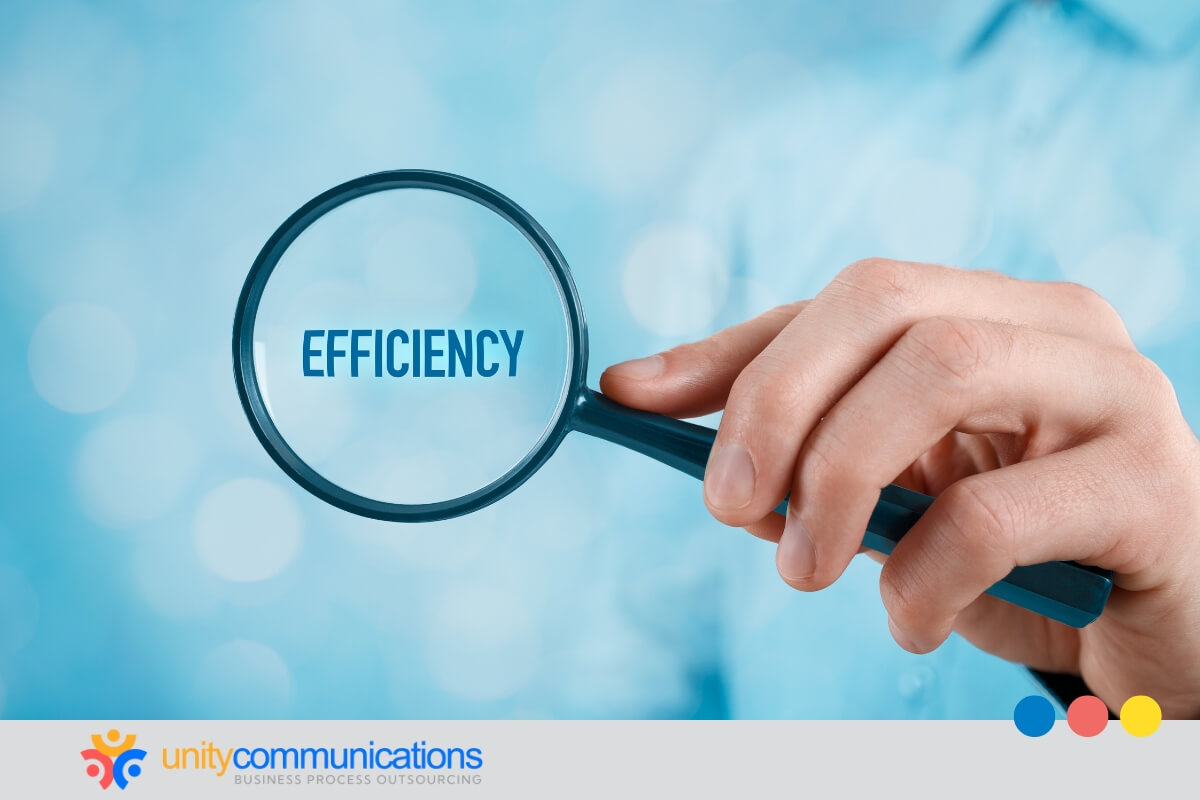Table of Contents
Consider this scenario: your business struggles to manage rising customer demands while juggling limited resources. Artificial intelligence (AI) now works with business process outsourcing (BPO) to bridge those gaps. Understanding AI agents is no longer optional for small and medium-sized businesses (SMBs).
This guide explores seven types of AI agents, their practical business applications, and how they transform outsourcing operations. You’ll learn which matches your goals and where to invest resources for maximum impact.
Why should you know the different types of AI agents?

You should know the various types of AI agents because they determine how automation supports your business decisions, customer service, and outsourced processes. Understanding them clarifies which models fit your goals and where to invest resources effectively.
For SMBs, this knowledge informs how you select a BPO partner and assess its ability to utilize AI responsibly. By understanding the roles of AI agents, you gain insight into the efficiency, adaptability, and long-term value that AI can bring to business operations.
When considering outsourcing, many SMB owners also ask about what BPO is. At its core, this practice shifts non-core tasks to a third-party contractor. When you know how AI agents integrate into BPO, you can understand the potential cost benefits, accuracy improvements, and customer service enhancements tied to advanced automation.
A study shows the global AI market could grow from $279.22 billion in 2024 to $3.5 trillion by 2033. This rise underscores the significant investment businesses are making in commercial deployment. AI agents are no longer experimental tools but proven drivers of efficiency and competitiveness.
You can connect this awareness directly to practical choices by asking:
- Which AI agents match your current outsourcing needs?
- How do service providers use AI in front-office and back-office roles?
- Where do AI agents improve responsiveness, decision-making, and scalability?
- How do AI agents reduce outsourcing compliance risks?
This perspective sets a strong foundation before exploring specific agent categories and their business applications.
Key AI agents in business
Each type of AI agent serves distinct roles, from automating interactions to guiding strategy. Understanding these categories helps you match AI capabilities to business priorities, boosting efficiency and accuracy.
Recent findings indicate that the use of AI has expanded across industries, with companies, on average, adopting AI in approximately three business functions in 2024. This emphasizes the importance of mapping agent categories to practical tasks so that the right models deliver measurable impact across business processes.
With this groundwork in place, let’s explore each category based on its core concept, key capabilities, business relevance, use case examples, and limitations or considerations.
1. Reflex agents
Reflex agents, the most basic types of AI agents, act instantly based on predefined rules or conditions. They do not rely on stored memory or advanced reasoning. Instead, they respond directly to inputs with predetermined outputs. Their simplicity makes them reliable in fast, repetitive processes.
- Core concept. Reflex agents match current input to a fixed response pattern. They are rule-driven and operate without considering historical data or future outcomes.
- Key capabilities. Their speed is their strength and reliability. You gain immediate reactions to specific triggers, which is valuable in high-volume, low-complexity tasks.
- Business relevance. As an SMB, you can apply reflex agents through BPO providers to streamline customer interactions or automate repetitive support workflows. This reduces manual workload and increases response consistency.
- Use case examples. Reflex agents power simple chatbots that handle frequently asked questions (FAQs), confirmations for scheduling, or updates on order status. They also support monitoring systems that detect and act on predefined anomalies, such as failed transactions or server errors.
- Limitations and considerations. These agents lack adaptability. They cannot learn, adjust, or deal with unstructured inquiries. Overreliance on them might frustrate customers who need nuanced support.
This foundation opens the way to exploring more advanced AI agent categories with greater flexibility.
2. Goal-based agents
Goal-based agents are a vital category among types of AI agents. Unlike reflex agents, they act with purpose, evaluating possible actions to achieve specific objectives. They consider the current state and potential outcomes before deciding the best course, making them more flexible in complex environments.
- Core concept. Goal-based agents analyze the current situation and select actions toward predefined objectives. They rely on environment models to predict outcomes and prioritize actions.
- Key capabilities. Their ability to plan sets them apart. You gain intelligent decision-making that aligns actions with targeted goals, improving operational effectiveness.
- Business relevance. SMBs can leverage goal-based agents through service providers to optimize workflows, allocate resources, and guide customer interactions toward desired outcomes. This enhances service efficiency and strategic alignment.
- Use case examples. These agents schedule deliveries along the most efficient route, guide customer support workflows to issue resolution, and prioritize tasks in project management dashboards. They also assist in financial decision-making by simulating potential outcomes.
- Limitations and considerations. They require accurate environment models and sufficient data. Incomplete models can lead to suboptimal decisions, and complex planning might increase processing time.
Understanding goal-based agents sets the stage for exploring more adaptive and multi-functional AI categories.
3. Utility-based agents
Utility-based agents are a strategic class among types of AI agents. They evaluate multiple options and pick the action that delivers the highest benefit, weighing trade-offs to find the best path in complex situations.
- Core concept. Utility-based agents evaluate possible actions against a utility function, which measures how well each option aligns with objectives. Decisions are guided by maximizing value and balancing competing factors.
- Key capabilities. Their decision optimization sets them apart. You gain intelligent prioritization that adapts dynamically to changing conditions, helping your business respond efficiently to varied challenges.
- Business relevance. SMBs can use utility-based agents through outsourcing providers to manage tasks where trade-offs matter. When combined with robotic process automation (RPA), these agents can automate decision-heavy workflows, such as invoice approvals, resource allocation, or customer escalation routing.
- Use case examples. Utility-based agents prioritize tickets, optimize inventory, and select suppliers by cost, reliability, and speed. They can also guide automated marketing campaigns for maximum engagement.
- Limitations and considerations. They require well-defined utility metrics and high-quality data. Poorly specified utility functions can lead to suboptimal or unintended decisions, and computation can be intensive in large-scale environments.
Grasping utility-based agents prepares you for understanding adaptive, learning-focused AI categories in business operations.
4. Learning agents
Learning agents are a progressive category among types of AI agents, designed to improve performance over time through experience and feedback. Unlike reflex or goal-based agents, they adapt to change, fitting dynamic operations where customer needs and conditions constantly evolve.
- Core concept. Learning agents track past actions, refine decisions, and adjust strategies to achieve better results over time. They rely on data, feedback loops, and sometimes reinforcement learning techniques.
- Key capabilities. Their adaptability sets them apart. You gain agents that improve automatically, helping your business respond to new challenges and optimize operations without constant manual input.
- Business relevance. Small businesses can leverage learning agents through outsourcing to enhance customer support, automate processes, and streamline decision-making workflows. These agents help maintain high service quality while reducing the need for repetitive monitoring efforts.
- Use case examples. Learning agents personalize chatbots, optimize call routing, refine maintenance schedules, and improve demand forecasting. They also support RPA workflows by adjusting rules based on observed outcomes.
- Limitations and considerations. They require quality data and careful training. Poor feedback or biased datasets can lead to suboptimal behavior, and implementation might be resource-intensive initially.
Recognizing the potential of learning agents enables you to implement smarter, adaptive AI strategies within your business workflows.
5. Multi-agent systems
Multi-agent systems represent a collaborative category among types of AI agents, where multiple intelligent agents interact, coordinate, or compete to achieve shared objectives. These systems excel in complex environments where tasks require distributed problem-solving and communication across agents.
- Core concept. Multi-agent systems comprise various autonomous agents that work together. Each agent acts independently while coordinating with others to achieve shared goals efficiently. Communication protocols guide their interactions.
- Key capabilities. Their collaborative intelligence sets them apart. You gain a system where agents divide tasks and solve problems more efficiently than a single agent could, boosting operational speed and decision quality.
- Business relevance. Companies and service providers use multi-agent systems to handle customer interactions, supply chains, and distributed data, reducing bottlenecks and enabling parallel tasks.
- Use case examples. These systems power AI-driven contact centers where agents share customer data, optimize routing, and handle concurrent inquiries. They also support automated supply chain optimization, collaborative content moderation, and fleet management.
- Limitations and considerations. Complexity in communication and conflict resolution can slow decisions. Designing effective protocols requires careful planning, and scaling might increase computational demands.
Learning how multi-agent systems function helps you adopt AI frameworks that leverage collaboration, maximize efficiency, and handle more intricate business challenges.
6. Interaction-focused agents
Interaction-focused agents are a key branch among types of AI agents. They deliver direct user communication, rapid responses, and seamless customer experiences across digital channels.
- Core concept. These agents specialize in interpreting language inputs, processing context, and delivering meaningful responses. They might rely on large-language models (LLMs) or scripted flows that balance automation with guided interaction.
- Key capabilities. Their strength lies in live interactive responses. You gain agents that answer inquiries instantly, guide transactions, and capture valuable customer data to boost service efficiency.
- Business relevance. For SMBs, interaction-focused agents extend service availability without extra staff. Service providers integrate them into support channels, letting businesses scale while maintaining responsive, conversational service.
- Use case examples. A 2024 survey reveals that 69% of respondents had not used an AI chatbot in the previous three months, indicating that many interactions remain untapped. Deploying these agents lets you capture missed opportunities, automate FAQs, support bookings, or handle multilingual inquiries.
- Limitations and considerations. These agents can struggle with complex or ambiguous inputs. Without proper training and escalation paths, they risk frustrating customers. Investing in continual refinement helps maintain trust.
Harnessing interaction-focused agents lets your business blend automation with approachable, human-like exchanges that customers value.
7. Information and analysis agents
Information and analysis agents are types of AI agents that gather and interpret data to derive actionable insights, enhancing operational efficiency and informing strategic decisions.
- Core concept. These agents gather data, analyze patterns, and provide reports, spotting trends and delivering predictive insights to guide decisions.
- Key capabilities. Their analytical strength sets them apart, giving you agents that process large datasets, reveal patterns, and deliver actionable insights faster than manual methods.
- Business relevance. SMBs can leverage these agents via service providers to improve reporting and market research. They enable data-driven decisions, streamline operations, and track key performance indicators (KPIs) without requiring an increase in headcount.
- Use case examples. They support financial forecasting, customer behavior analysis, fraud detection, and resource planning. Additionally, they can feed insights to other AI workflows, including predictive maintenance and RPA, increasing business intelligence.
- Limitations and considerations. Reliable performance relies on data quality, integration capabilities, and the proper selection of algorithms. Poor data inputs can lead to flawed insights.
Market projections indicate that the global AI adoption in BPO could expand from $2.6 billion in 2023 to approximately $49.6 billion by 2033, highlighting why these agents are essential for scalable, intelligent business operations.
Outsourcing with AI agents for business efficiency

AI agents streamline outsourcing by automating workflows, reducing costs, and enhancing service efficiency. For SMBs, this shift frees you to focus on strategy while AI-powered teams handle back-office functions and customer-facing operations.
AI and BPO now drive scalability and tailored support by combining innovative tools with traditional outsourcing. Their combination reduces manual work and provides your business with flexible, faster, and more reliable services.
Still, BPO challenges include data risks and service issues. AI addresses them by monitoring compliance, utilizing predictive analytics, and sending real-time alerts that ensure outsourced operations remain consistent and reliable.
The global BPO market is projected to reach $840.6 billion by 2034. Firms using automation and the types of AI agents in outsourcing will benefit from this surge, positioning themselves for stronger long-term growth.
How outsourcing providers use AI agents
The distinction matters when comparing outsourcing vs. offshoring. Offshoring involves relocating services to another country, whereas outsourcing can be local or global. AI agents drive efficiency, accuracy, and flexibility across both models.
To understand how outsourcing works with AI, consider virtual agents handling inquiries, predictive models aligning staffing, and automated reporting delivering actionable insights. These ease manual strain while sustaining consistent service levels.
Practical applications include:
- Predictive scheduling aligns staffing with demand
- AI monitoring safeguards compliance and performance
- AI-powered virtual assistants deliver 24/7 client support
These uses demonstrate how AI strengthens BPO provider capabilities while meeting your service expectations.
Benefits for small and medium-sized enterprises
Adopting outsourcing delivers clear BPO advantages for SMBs. With AI managing repetitive tasks, your team can allocate more time to innovation while reducing costs through automation-driven support.
For BPO for small businesses, AI-driven outsourcing delivers enterprise-level service at a fraction of the cost. Additionally, flexible BPO pricing models let you pay by transaction, hour, or outcome, aligning costs with growth and scaling smoothly.
Key benefits include:
- Expert AI resources without heavy investment
- Affordable scalability as workloads rise
- Faster, data-driven customer interactions
These strengths help SMBs sharpen competitiveness while staying cost-efficient.
Practical use cases in outsourced operations
A standout use case for AI in customer service is the use of chatbots to manage inquiries. They deliver instant replies, escalate complex issues, and maintain accuracy while reducing support costs and increasing client satisfaction.
Other relevant applications include:
- Automated billing and invoicing with error detection
- AI-driven fraud prevention in financial workflows
- Smart assistants supporting supply chain operations
These examples illustrate how AI agents enhance outsourced processes while improving departmental efficiency.
The bottom line
The AI revolution in BPO is here. Organizations already deploying the seven types of AI agents covered in this guide are capturing competitive advantages through reduced costs, improved customer experiences, and scalable operations.
AI and BPO now collaborate to automate manual tasks, enhance efficiency, and ensure consistent, high-quality results. This partnership empowers your team to focus on strategy while automation drives reliability and growth across every type of AI agent.
Ready to explore AI-powered BPO for your business? Let’s connect to discuss which AI agent types align with your operational goals and how we can help you implement them effectively.




